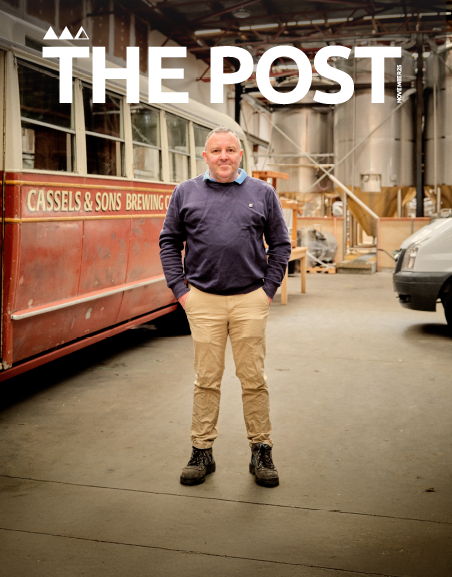Goldpine
Walter Peak High Country Farm: A Taste of Rural Tourism
It’s a known fact that Queenstown is a popular attraction for Kiwis and overseas tourists, with breath-taking landscapes and stunning views of Lake Wakatipu. Adding to its charm is NZ’s oldest passenger carrying steamship, the 48-metre long TSS Earnslaw, that has been in operation for over 100 years. This unique 45-minute voyage sends you across the lake to Walter Peak High Country Farm, a property containing a beautiful garden, an old homestead, friendly farm animals, and a catered restaurant.
Walter Peak, like many farms, has a unique history. It was originally used as a camping site by Māori, who used the bays to rest as they journeyed the Mararoa and Ōreti Rivers to seek Moa and gather pounamu (also known as greenstone). After farming attempts in the 1860s by Nicholas von Tunzelmann, it was then taken over by the Mackenzie family in the late 1880s, who turned it into a successful, functioning high country station.
Today, the station is split into two parts: a high-country working farm that spans just over 25,000 hectares, running 20,000 merino sheep and some Angus cattle; and the other part, Walter Peak High Country Farm, a 155-hectare property that includes the original homestead block and is heavily focused on tourism.
Peter Hamilton is the rural operations coordinator at RealNZ and looks after the farm grounds, tours, and dog shows. Originally from Southland, Peter has a long background in farming, with his parents running a sheep and beef farm when he was growing up, which was later converted to dairy. He has always been passionate about training sheep dogs and knew that it was his calling to focus his time on just that. When he saw a job at Walter Peak pop up online, he only intended for it to be a six-month summer job; eight years later, Peter is still there.
RealNZ started off by running charters on the TSS Earnslaw as their main attraction. Soon after, they extended their tourism opportunities to feature Walter Peak Farm, encouraging tourists to come and visit a farm and showcase the best that rural New Zealand has to offer. The farm has a wide range of animals on a small scale to delight visitors, including different types of deer, three different breeds of goats, big-horned Highland cattle, baby lambs and calves, Kunekune pigs, alpacas, retired donkeys and a pack of working dogs. They mostly have sheep and cattle on farm, with the numbers, age groups and breeds changing frequently. When their sheep are shorn, the wool is pressed in their woolshed on site and transported to the wool brokers in Te Anau.
The day-to-day activities on farm are overwhelmingly spectacular to tourists that visit Walter Peak – even the sheep are fascinating. The farm has 50 to 60 staff, including those working on the Earnslaw, and ten on Peter’s team, who are passionate about educating visitors on how things are done on a working farm. In the peak season, the farm has around 800 visitors a day who get to explore the farm, relax in the garden, and enjoy a nice lunch or afternoon tea at the restaurant.
“We get to show our visitors how sheep are shorn; how it’s safe for the sheep, that it’s not causing any harm, and how, in fact, you’re helping the sheep. We also get to show them the working dogs and how much they love to work. This is something that these visitors have never experienced before, so it’s a good education for them,” Peter said.
Along with Walter Peak’s popular guided walking tour to visit and feed the animals, they have introduced an eco-tour that launched on the 20th of December to diversify and showcase their sustainable practices.
“A big part of the tour is focusing on growing our produce here. The idea is to produce the majority of our food on site which we can serve to our guests at the homestead and in the restaurant. We’ll also have guests out planting trees, and a native nursery so we can begin growing our own native trees on site as well.”
“Our main conservation and sustainability projects include fencing off areas to exclude stock and preserving them by planting natives. We’re currently doing some planting and trapping programmes and have around 150 traps to keep pests under control and help our native species. We’ve got native falcons that breed here every year; it’s rare to see falcons like that.”
If you don’t find Peter out on the farm, he spends his spare time in the workshop tinkering away on his big metal Haast’s eagle, which he mentioned keeps him entertained and ties in well with wanting to prevent those endangered species from also becoming extinct.
The station is getting more involved in tree planting, with 16 Queenstown students due the day after we visited to spend the day doing just that. Walter Peak also works with a few nurseries in Queenstown that support them in their venture of propagating natives.
“One of the best things about working here is being able to live here. There’s around 20 of us that do, and it’s such an amazing place to live. I also get to work with these great dogs and some great people all day, every day, so it’s a pretty awesome job,” Peter said.
With its closest town being Mossburn, an hour and fifteen minutes drive away or a three-and- a-half hours’ drive from Queenstown, Walter Peak is quaint and remote. It certainly does have that ‘wow factor’ and a unique location. The best way to experience it is to take the TSS Earnslaw from Queenstown’s Steamer Wharf to visit this little slice of rural paradise.


.jpg)


